| Revision as of 20:59, 6 December 2013 edit216.56.36.162 (talk)No edit summary← Previous edit | Revision as of 21:00, 6 December 2013 edit undo216.56.36.162 (talk)No edit summaryNext edit → | ||
| Line 2: | Line 2: | ||
| ], Japan.]] | ], Japan.]] | ||
| Awhen air flows over and under the kite's wing, producing low pressure above the wing and high pressure below it. This deflection also generates horizontal ] along the |
Awhen air flows over and under the kite's wing, producing low pressure above the wing and high pressure below it. This deflection also generates horizontal ] along the and for recreation |publisher=G. P. Putnam's sons |year=1896 |oclc=2273288 }}</ref><ref>] Scientist in the Field Gathering atmospheric dynamics data using kites. Kites are anchored rgvfedfefefdfefefefefewww.drachen.org/journals/journal22/Journal-22/TalStreet.pdf Kite Fashions: Above, Below, Sideways. Expert kiter sometimes ties a flying kite to a tree to have the kite fly for days on end.]{{dead link|date=October 2012}}</ref> | ||
| The same principles can be used in water<ref>{{cite web|url=http://2lo.de/kitedive/index.htm |title=Underwater kiting |publisher=2lo.de |date= |accessdate=2012-10-03}}</ref><ref>{{cite web|url=http://www.google.com/patents?id=xldbAAAAEBAJ |title=Hydro kite angling device Jason C. Hubbart |publisher=Google.com |date= |accessdate=2012-10-03}}</ref><ref>{{cite web|url=http://www.google.com/patents?id=6plmAAAAEBAJ |title=Underwater kite F. G. Morrill |publisher=Google.com |date= |accessdate=2012-10-03}}</ref> and experiments have also been made with lighter-than-air kites (]s)<ref>{{cite journal|last=Streeter |first=Tal |url=http://drupal.drachen.org/sites/default/files/pdf/Journal%20Issue%2010.pdf |title=Domina Jalbert: Brother of the Wind |format=PDF |journal=Drachen Foundation Journal |date=Fall 2002 |issue=10 |accessdate=2012-10-03 |pages=41–44}}</ref> | The same principles can be used in water<ref>{{cite web|url=http://2lo.de/kitedive/index.htm |title=Underwater kiting |publisher=2lo.de |date= |accessdate=2012-10-03}}</ref><ref>{{cite web|url=http://www.google.com/patents?id=xldbAAAAEBAJ |title=Hydro kite angling device Jason C. Hubbart |publisher=Google.com |date= |accessdate=2012-10-03}}</ref><ref>{{cite web|url=http://www.google.com/patents?id=6plmAAAAEBAJ |title=Underwater kite F. G. Morrill |publisher=Google.com |date= |accessdate=2012-10-03}}</ref> and experiments have also been made with lighter-than-air kites (]s)<ref>{{cite journal|last=Streeter |first=Tal |url=http://drupal.drachen.org/sites/default/files/pdf/Journal%20Issue%2010.pdf |title=Domina Jalbert: Brother of the Wind |format=PDF |journal=Drachen Foundation Journal |date=Fall 2002 |issue=10 |accessdate=2012-10-03 |pages=41–44}}</ref> | ||
Revision as of 21:00, 6 December 2013
For other uses, see Kite (disambiguation).
Awhen air flows over and under the kite's wing, producing low pressure above the wing and high pressure below it. This deflection also generates horizontal drag along the and for recreation |publisher=G. P. Putnam's sons |year=1896 |oclc=2273288 }}</ref>
The same principles can be used in water and experiments have also been made with lighter-than-air kites (kytoons)
Kites may be flown for recreation, art or other practical uses. Sport kites can be flown in aerial ballet, sometimes as part of a competition. Power kites are multi-line steerable kites designed to generate large forces which can be used to power activities such as kite surfing, kite landboarding, kite fishing, kite buggying and a new trend snow kiting. Kites towed behind boats can lift passengers which has had useful military applications in the past.
History
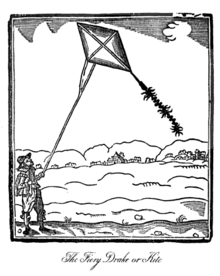
Kites were invented in China, where materials ideal for kite building were readily available: silk fabric for sail material; fine, high-tensile-strength silk for flying line; and resilient bamboo for a strong, lightweight framework.
The kite has been claimed as the invention of the famous 5th-century BC Chinese philosophers Mozi (also Mo Di) and Lu Ban (also Gongshu Ban). Earlier kites were used as leaf kites. By at least 549 AD paper kites were being flown, as it was recorded in that year a paper kite was used as a message for a rescue mission. Ancient and medieval Chinese sources list other uses of kites for measuring distances, testing the wind, lifting men, signaling, and communication for military operations. The earliest known Chinese kites were flat (not bowed) and often rectangular. Later, tailless kites incorporated a stabilizing bowline. Kites were decorated with mythological motifs and legendary figures; some were fitted with strings and whistles to make musical sounds while flying.
After its introduction into India, the kite further evolved into the fighter kite known as the patang in India where thousands are flown every year on festivals such as Makar Sankranti.
Kites were known throughout Polynesia, as far as New Zealand, with the assumption being that the knowledge diffused from China along with the people. Anthropomorphic kites made from cloth and wood were used in religious ceremonies to send prayers to the gods. Polynesian kite traditions are used by anthropologists get an idea of early "primitive" Asian traditions that are believed to have at one time existed in Asia.

Kites were late to arrive in Europe, although windsock-like banners were known and used by the Romans. Stories of kites were first brought to Europe by Marco Polo towards the end of the 13th century, and kites were brought back by sailors from Japan and Malaysia in the 16th and 17th centuries. Although they were initially regarded as mere curiosities, by the 18th and 19th centuries kites were being used as vehicles for scientific research.
In 1750, Benjamin Franklin published a proposal for an experiment to prove that lightning is electricity by flying a kite in a storm that appeared capable of becoming a lightning storm. It is not known whether Franklin ever performed his experiment, but on May 10, 1752, Thomas-François Dalibard of France conducted a similar experiment (using a 40-foot (12 m) iron rod instead of a kite) and extracted electrical sparks from a cloud.
Kites were also instrumental in the research and development of the Wright brothers when building the first airplane in the late 1800s. Over the next 70 years, many new kite designs were developed, and often patented. These included Eddy's tail-less diamond kite, the tetrahedral kite, the flexible kite, the sled kite, and the parafoil kite, which helped to develop the modern hang-gliders. In fact, the period from 1860 to about 1910 became the "golden age of kiting". Kites started to be used for scientific purposes, especially in meteorology, aeronautics, wireless communications and photography; many different designs of man-lifting kite were developed as well as power kites.
The development of mechanically powered airplane diminished interest in kites. World War II saw a limited use of kites for military purposes (see Focke Achgelis Fa 330 for example). Since then they are used mainly for recreation.
Materials

Designs often emulate flying insects, birds, and other beasts, both real and mythical. The finest Chinese kites are made from split bamboo (usually golden bamboo), covered with silk, and hand painted. On larger kites, clever hinges and latches allow the kite to be disassembled and compactly folded for storage or transport. Cheaper mass-produced kites are often made from printed polyester rather than silk.
Tails are used for some single-line kite designs to keep the kite's nose pointing into the wind. Spinners and spinsocks can be attached to the flying line for visual effect. There are rotating wind socks which spin like a turbine. On large display kites these tails, spinners and spinsocks can be 50 feet (15 m) long or more.
Modern acrobatic kites use two or four lines to allow fine control of the kite's angle to the wind. Traction kites may have an additional line to de-power the kite and quick-release mechanisms to disengage flyer and kite in an emergency.
Practical uses
Main article: Kite applications
Human flight
Humans are sometimes bound to a large kite to fly. The first known example is Yuan Huangtou in 550 CE.
Military applications
Kites have been used for military purposes in the past, such as signaling, delivery of munitions, and for observation, both by lifting an observer above the field of battle and by using kite aerial photography.
According to Samguk Sagi, in 637 Kim Yu-sin, a Korean general of Silla rallied his troops to defeat rebels by lofting a kite with a straw man which looked like a burning ball flying to the sky.
Russian chronicles mention Prince Oleg of Novgorod use of kites during the siege of Constantinople in 906: "and he crafted horses and men of paper, armed and gilded, and lifted them into the air over the city; the Greeks saw them and feared".
Kites were also used by Admiral Yi of the Joseon Dynasty (1392-1910) of Korea. During the Japanese invasions of Korea (1592–1598), Admiral Yi commanded his navy using kites. His kites had specific markings directing his fleet to perform various orders.

In the modern era the British Army used kites to haul human lookouts into the air for observation purposes, using the kites developed by Samuel Franklin Cody. Barrage kites were used to protect shipping during the Second World War. Kites were also used for anti-aircraft target practice. Kites and kytoons were used for lofting communications antenna. Submarines lofted observers in rotary kites.
Science and meteorology
Kites have been used for scientific purposes, such as Benjamin Franklin's famous experiment proving that lightning is electricity. Kites were the precursors to the traditional aircraft, and were instrumental in the development of early flying craft. Alexander Graham Bell experimented with very large man-lifting kites, as did the Wright brothers and Lawrence Hargrave. Kites had a historical role in lifting scientific instruments to measure atmospheric conditions for weather forecasting.
Radio aerials and light beacons
Kites can be used for radio purposes, by kites carrying antennas for MF, LF or VLF-transmitters. This method was used for the reception station of the first transatlantic transmission by Marconi. Captive balloons may be more convenient for such experiments, because kite-carried antennas require a lot of wind, which may be not always possible with heavy equipment and a ground conductor. It must be taken into account during experiments, that a conductor carried by a kite can lead to a high voltage toward ground, which can endanger people and equipment, if suitable precautions (grounding through resistors or a parallel resonant-circuit tuned to transmission frequency) are not taken.
Kites can be used to carry light effects such as lightsticks or battery powered lights.
Kite traction
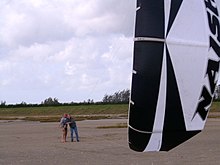
Kites can be used to pull people and vehicles downwind. Efficient foil-type kites such as power kites can also be used to sail upwind under the same principles as used by other sailing craft, provided that lateral forces on the ground or in the water are redirected as with the keels, center boards, wheels and ice blades of traditional sailing craft. In the last two decades several kite sailing sports have become popular, such as kite buggying, kite landboarding, kite boating and kite surfing. Snow kiting has also become popular in recent years.
Kite sailing opens several possibilities not available in traditional sailing:
- Wind speeds are greater at higher altitudes
- Kites may be manoeuvered dynamically which increases the force available dramatically
- There is no need for mechanical structures to withstand bending forces; vehicles or hulls can be very light or dispensed with all together
Cultural uses

Kite festivals are a popular form of entertainment throughout the world. They include large local events, traditional festivals which have been held for hundreds of years and major international festivals which bring in kite flyers from Britain to display their unique art kites and demonstrate the latest technical kites.
Asia

Kite flying is popular in many Asian countries, where it often takes the form of 'kite fighting', in which participants try to snag each other's kites or cut other kites down. Fighter kites are usually small, flat, flattened diamond-shaped kites made of paper and bamboo. Tails are not used on fighter kites so that agility and maneuverability are not compromised.
In Afghanistan, kite flying is a popular game, and is known in Dari as Gudiparan Bazi. Some kite fighters pass their strings through a mixture of ground glass powder and glue, which is legal. The resulting strings are very abrasive and can sever the competitor's strings more easily. The abrasive strings can also injure people. During the Taliban rule in Afghanistan, kite flying was banned, among various other recreations.
In Pakistan, kite flying is often known as Gudi-Bazi or Patang-bazi. Although kite flying is a popular ritual for the celebration of spring festival known as Jashn-e-Baharaan (lit. Spring Festival) or Basant, kites are flown throughout the year. Kite fighting is a very popular all around Pakistan, but centered in urban centers across the country especially Lahore. The kite fights are at their maximum during the spring celebrations and the fighters enjoy competing with rivals in which one have to cut-loose the string of the kite of other, this is popularly called as "Paecha". During the spring festival, kite flying competitions are held across the country and the skies are colored with kites. As people cut-loose an opponents kites, shouts of 'wo kata' ring through the air. Reclaiming the kites, after they have been cut-loose by running after them, is a popular ritual especially among the youth (similar to scenes depicted in the Kite Runner which is based in neighboring Afghanistan). Kites and strings are a big business in the country and many types of strings are used: glass-coated strings, metal strings and tandi. However, kite flying was recently banned in Punjab due to recent motorcyclist deaths caused by glass-coated or metal kite-strings. Kup, Patang, Guda, and Nakhlaoo are some of the kites used. They vary in balance, weight and speed through the air.
In Vietnam, kites are flown without tails. Instead small flutes are attached allowing the wind to "hum" a musical tune. There are other forms of sound-making kites. In Bali, large bows are attached to the front of the kites to make a deep throbbing vibration, and in Malaysia row of gourds with sound-slots are used to create a whistle as the kite flies.

Kites are very popular in India, with the states of Bihar, Jharkhand, Gujarat, West Bengal, Rajasthan and Punjab notable for their kite fighting festivals. Highly maneuverable single-string paper and bamboo kites are flown from the rooftops while using line friction in an attempt to cut each other's kite lines, either by letting the cutting line loose at high speed or by pulling the line in a fast and repeated manner. During the Indian spring festival of Makar Sankranti, near the middle of January, millions of people fly kites all over northern India. Kite flying in Hyderabad starts a month before this, but kite flying/fighting is an important part of other celebrations, including Republic Day, Independence Day, Raksha Bandhan, Viswakarma Puja day in late September and Janmashtami. An international kite festival is held every year before Uttarayan for three days in Vadodara, Surat and Ahmedabad.

Weifang, Shandong, China is the kite capital of the world. China is the oldest place, probably with India where kites have been flown since antiquities. It is home to the largest kite museum in the world, the thousands of kites here have a display area of 8100 m. Weifang hosts an annual international kite festival on the large salt flats south of the city. There are several kite museums in Japan, UK, Malaysia, Indonesia, Taiwan, Thailand and the USA.
In the olden days, Malays in Singapore, kites were used for fishing.
Europe
In Greece and Cyprus, flying kites is a tradition for Clean Monday, the first day of Lent. In the British Overseas Territory of Bermuda, traditional Bermuda kites are made and flown at Easter, to symbolise Christ's ascent. Bermuda kites hold the world records for altitude and duration. In Fuerteventura a kite festival is usually held on the weekend nearest to 8 November lasting for 3 days.
Polynesia

Polynesian traditional kites are sometimes used at ceremonies and variants of traditional kites for amusement. Older pieces are kept in museums.
South America
In Chile, kites are very popular, especially during Independence Day festivities (September 18).
In Colombia, kites can be seen flown in parks and recreation areas during August which is known to be windy. It is during this month that most people, especially the young ones would fly kites.
In Guyana, kites are flown at Easter, an activity in which all ethnic and religious groups participate. Kites are generally not flown at any other time of year. Kites start appearing in the sky in the weeks leading up to Easter and school children are taken to parks for the activity. It all culminates in a massive airborne celebration on Easter Monday especially in Georgetown, the capital, and other coastal areas. The history of the practice is not entirely clear but given that Easter is a Christian festival, it is said that kite flying is symbolic of the Risen Lord. Moore describes the phenomenon in the 19th century as follows:
A very popular Creole pastime was the flying of kites. Easter Monday, a public holiday, was the great kite-flying day on the sea wall in Georgetown and on open lands in villages. Young and old alike, male and female, appeared to be seized by kite-flying mania. Easter 1885 serves as a good example. “The appearance of the sky all over Georgetown, but especially towards the Sea Wall, was very striking, the air being thick with kites of all shapes and sizes, covered with gaily coloured paper, all riding bravely on the strong wind"
(His quotation is from a letter to The Creole newspaper of December 29, 1858). The exact origins of the practice of kite flying (exclusively) at Easter are unclear. Brereton and Yelvington speculate that kite flying was introduced by Chinese indentured immigrants to the then colony of British Guiana in the mid 19th century. The author of an article in the Guyana Chronicle newspaper of May 6, 2007 is more certain:
Kite flying originated as a Chinese tradition to mark the beginning of spring. However, because the plantation owners were suspicious of the planter class (read "plantation workers"), the Chinese claimed that it represented the resurrection of Jesus Christ. It was a clever argument, as at that time, Christians celebrated Easter to the glory of the risen Christ. The Chinese came to Guyana from 1853-1879.
In Brazil, flying a kite is a very popular leisure activity for children and teenagers, mostly boys, sometimes even young adults. It overwhelmingly consists in kite fighting followed by kite running, a game whose goal is to maneuver their own kites to cut the other persons' kites' strings during flight, and then proceed in a race through the streets to steal the free-drifting kites. This is often done with the aid of powdered glass or aluminium glued to the string, creating a very sharp micro-serration. This practice is illegal as it increases the odds of fatal accidents with motorcyclists, cyclists, children, older people, and animals. Motorcycles are required to have an antenna with a tiny sickle on the edge to protect the rider as the laws prohibiting the use of these strings is largely disobeyed by the population.
Popular culture
- The Kite Runner, a 2005 novel by Khaled Hosseini dramatizes the role of kite fighting in pre-war Kabul.
- The Peanuts cartoon character Charlie Brown was often depicted having flown his kite into a tree as a metaphor for life's adversities.
General safety issues
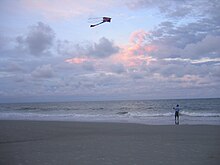
There are safety issues involved in kite-flying, more so with power kites. Kite lines can strike and tangle on electrical power lines, causing power blackouts and running the risk of electrocuting the kite flier. Wet kite lines or wire can act as a conductor for static electricity and lightning when the weather is stormy. Kites with large surface area or powerful lift can lift kite fliers off the ground or drag them into other objects. In urban areas there is usually a ceiling on how high a kite can be flown, to prevent the kite and line infringing on the airspace of helicopters and light aircraft.
Designs

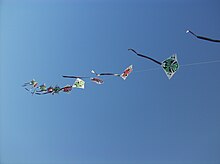
- Bermuda kite
- Bowed kite, e.g. Rokkaku
- Cellular or box kite
- Chapi-chapi
- Foil, parafoil or bow kite
- Leading edge inflatable kite
- Malay kite see also wau bulan
- Tetrahedral kite
Types
Main article: Kite types- Expanded polystyrene kite
- Fighter kite
- Indoor kite
- Inflatable single-line kite
- Kytoon
- Man-lifting kite
- Rogallo parawing kite
- Stunt (sport) kite
- Water kite
Line materials
- Cotton
- Dacron
- Dyneema
- Hemp
- Kevlar
- Linen
- Manja or Manjha, Hindi word for the glass powder coated kite flying & fighting string from Indian subcontinent and surrounding regions
- Nylon
- Polyester
- Rayon
- Silk
- Ultra-high-molecular-weight polyethylene
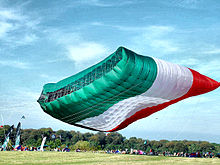
Record
Until Bristol Kite Festival 2011 ended, the world record for the biggest-ever kite flown for at least 20 minutes was a kite with lifting area of 10,971 square feet.
See also
- Airborne wind turbine — conceptual for wind generator flown as kite
- Captive helicopter
- Captive plane
- High altitude wind power
- Kite aerial photography
- Kite buggying
- Kite fishing
- Kite ice skating
- Kite landboarding
- Kite shape (geometry)
- Kiteboating
- Kitelife — an American magazine devoted to kites.
- Kitesurfing
- List of books about kites
- List of kite festivals
- Sea Tails, video installation
- Solar balloon A solar-heated hot air balloon that can be flown like a kite, but on windless days.
- Uttarayan The kite flying festival of western India
References
- Science in the Field: Ben Balsley, CIRES Scientist in the Field Gathering atmospheric dynamics data using kites. Kites are anchored rgvfedfefefdfefefefefewww.drachen.org/journals/journal22/Journal-22/TalStreet.pdf Kite Fashions: Above, Below, Sideways. Expert kiter sometimes ties a flying kite to a tree to have the kite fly for days on end.
- "Underwater kiting". 2lo.de. Retrieved 2012-10-03.
- "Hydro kite angling device Jason C. Hubbart". Google.com. Retrieved 2012-10-03.
- "Underwater kite F. G. Morrill". Google.com. Retrieved 2012-10-03.
- Streeter, Tal (Fall 2002). "Domina Jalbert: Brother of the Wind" (PDF). Drachen Foundation Journal (10): 41–44. Retrieved 2012-10-03.
- Deep In the Heart of Texas by Dave Broyles Boat kiting
- "Focke-Achgelis Fa 330A-1 Bachsteltze (Water Wagtail)". Smithsonian National Air and Space Museum. Retrieved 2012-10-03.
- Yinke, Deng (2005). Ancient Chinese inventions. Cambridge: Cambridge University Press. p. 122. ISBN 978-0-521-18692-6.
- ^ Needham, Volume 4, Part 1, 127.
- "Amazing Musical Kites", Cambodia Philately
- Kite Flying for Fun and Science, 1907, The New York Times.
- "Khmer Kites", Sim Sarak and Cheang Yarin, Ministry of Culture and Fine Arts, Cambodia 2002
- Tripathi, Piyush Kumar (7 January 2012). "Kite fights to turn skies colourful on Makar Sankranti - Professional flyers to showcase flying skills; food lovers can relish delicacies at snack huts". The Telegraph. Calcutta, India.
- Tarlton, John. "Ancient Maori Kites". Ancient Maori Kites. Retrieved 19 October 2011.
- Chadwick, Nora K. (1931-07). "The Kite: A Study in Polynesian Tradition". Journal of the Royal Anthropological Institute. 61: 455. doi:10.2307/2843932. ISSN 0307-3114.
{{cite journal}}: Check date values in:|date=(help) - ^ Anon. "Kite History: A Simple History of Kiting". G-Kites. Retrieved 20 June 2010.
- ^ "Franklin's Kite". Mos.org. Retrieved 2012-10-03.
- "Bolt Of Fate: Benjamin Franklin And His Electric Kite Hoax: Tommy N. Tucker". Amazon.com. Retrieved 2012-10-03.
- "History of Kites". Retrieved 18 April 2012.
- "연 鳶 (Yeon)" (in Korean). Nate / Encyclopedia of Korean Culture. Retrieved July 30, 2009.
- "신호연신호 개요 (Summary of sending a signal with a kite)" (in Korean). Korea Culture & Contents Agency. Retrieved July 30, 2009.
- M. Robinson. "Kites On The Winds of War". Members.bellatlantic.net. Retrieved 2012-10-03.
- Saul, Trevor (August 2004). "Henry C Sauls Barrage Kite". Soul Search. Retrieved 2012-10-03.
- Grahame, Arthur (May 1945). "Target Kite Imitates Plane's Flight". Popular Science. Retrieved 2012-10-03.
{{cite journal}}: Cite journal requires|journal=(help) - "World Kite Museum". World Kite Museum. Retrieved 2012-10-03.
- Focke Achgelis Fa 330
- "Kite.(2007) Encyclopædia Britannica Online". Britannica.com. Retrieved 2013-04-22.
- Pogadaev, Victor. Svetly Mesyatz-Zmei Kruzhitsa (My Lord Moon Kite) - “Vostochnaya Kollektsia” (Oriental Collection). M.: Russian State Library. N 4 (38), 2009, 129-134. ISSN 1681—7559
- Skeat, Walter William (1965). Malay Magic: An Introduction to the Folklore and Popular Religion of the Malay Peninsular. p. 485. ISBN 978-0-7146-2026-8.
- Moore, Brian L. (1995). Cultural Power, Resistance, and Pluralism: Colonial Guyana 1838-1900. McGill-Queen's Press - MQUP, ISBN 978-0-7735-1354-9
- Brereton, Bridget; Yelvington, Kevin A. (1999). The Colonial Caribbean in Transition. University Press of Florida, ISBN 978-0-8130-1696-2
- Guyana Chronicle.
- by tudobeleza (2012-05-06). "Flying High: Kids & Kites". Eyes On Brazil. Retrieved 2013-04-22.
- Buckland, Lucy (September 4, 2011). "World's biggest kite - larger than a football pitch - fails to soar at Bristol festival". Daily Mail. London.
External links
- Template:Dmoz
- Kite is in many countries a tradition that accompanies everyday life and major events...
- History of kites
- The earliest depiction of kite flying in European literature in a panorama of Ternate (Moluccas) 1600.
- Mathematics and aeronautical principles of kites.
- Kitecraft and Kite Tournaments (1914) — A free public domain e-book
- Kite World Records and Innovations
- Kite Museum in India
- Trivedi, Parthsarathi; et al. "Aerodynamics of Kites" (PDF). Retrieved 8 February 2013.
{{cite web}}: Explicit use of et al. in:|first=(help) - Eyes on Brazil
- First Disabled Kite Club
- Kite Painting & Making Limca Book of Records 2013
- Hungarian Kite Dedicated Website - Kites.hu
- Kite Flyers India - Official
| Application of wind energy | |
|---|---|
| Wind power | |
| Vehicle propulsion | |
| Kite applications | |
| Air current | |
| Types of aircraft by methods of thrust and lift | |||||||||||||||||||||||||
|---|---|---|---|---|---|---|---|---|---|---|---|---|---|---|---|---|---|---|---|---|---|---|---|---|---|
| |||||||||||||||||||||||||
| |||||||||||||||||||||||||
| Kites and kite flying | ||
|---|---|---|
| Types by use |  | |
| Types by shape | ||
| Activities and applications | ||
| Parts | ||
| People | ||
| Other | ||